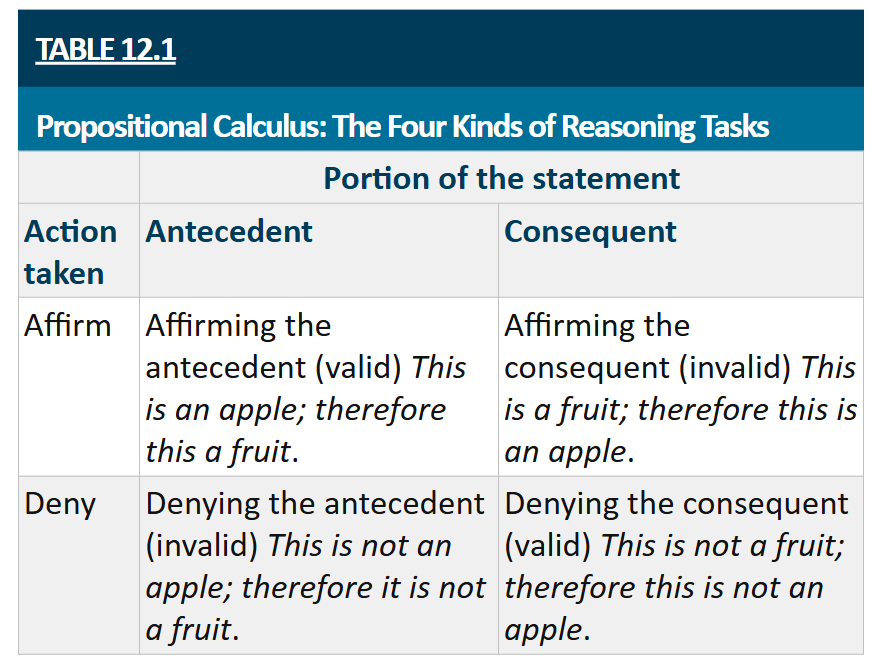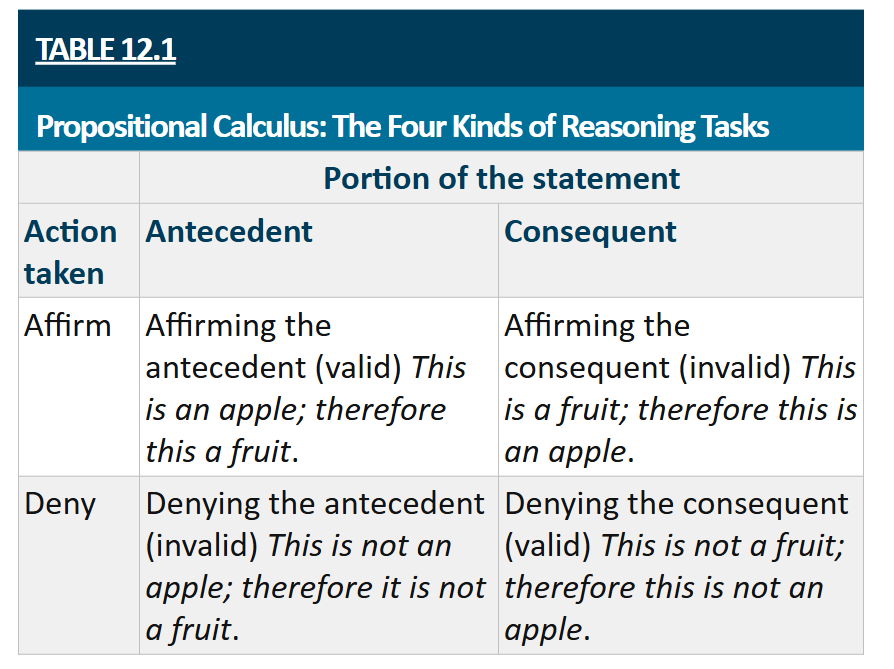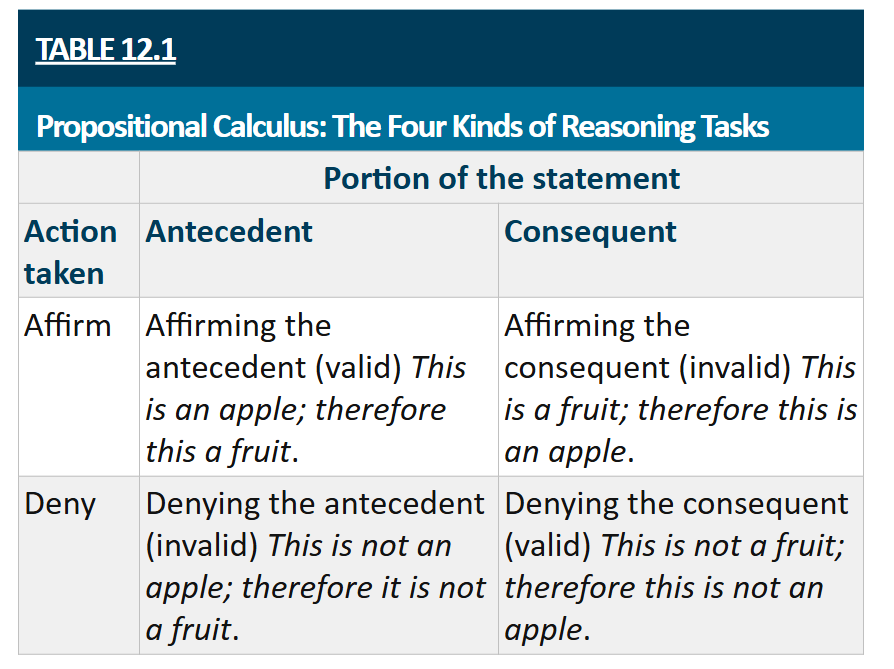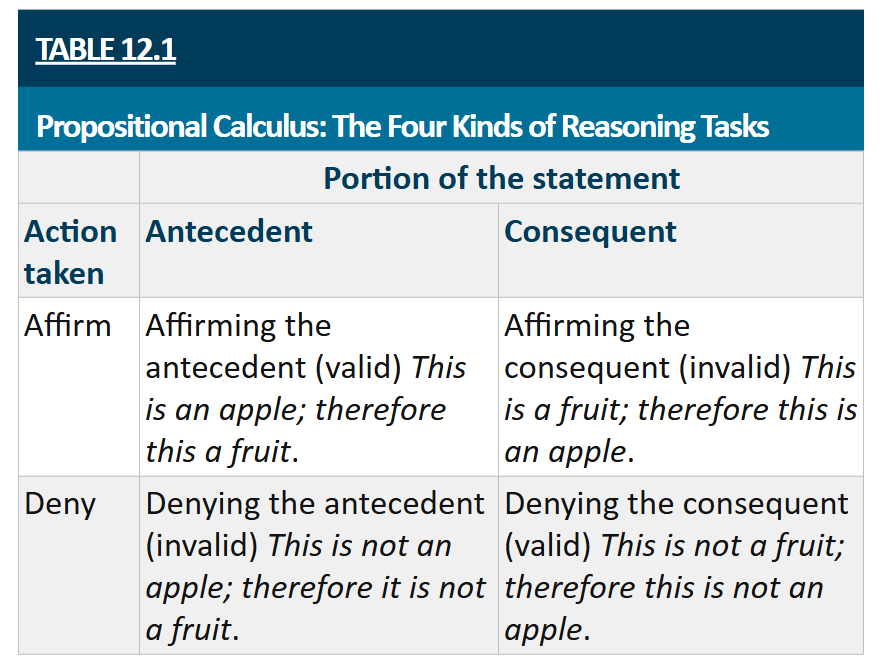Cognitive Psychology Exam 4 Study Guide
1/104
There's no tags or description
Looks like no tags are added yet.
Name | Mastery | Learn | Test | Matching | Spaced |
|---|
No study sessions yet.
105 Terms
deductive reasoning
type of reasoning where you start with some statements that are true. then ypu judge whether these statements allow you to draw a specific conclusion, based on logic
conditional reasoning task (propositional reasoning task)
describes the relationship between conditions
example: if a child is allergic to peanuts, then eating peanuts produces a breathing problem. child has a breathing problem, therefore this child has eaten peanuts
syllogism
two statements that we must assume to be true, plus a conclusion (usually uses the words all, none, some
ex: some psychology majors are friendly people, some friendly people are concerned about poverty, therefore some psychology majors are concerned about poverty
propositional calculus
system for categorizing the four kinds of reasoning used in analyzing propositions or statement

propositions
statements that are made up of antecedents and consequents
antecedent
first proposition or statement
consequent
the proposition that comes second
affirming the antecedent
you say the if part if the sentence is true, valid conclusion

affirming the consequent
you say the then part of the sentence is true, invalid conclusion

denying the antecedent
the “if…” part of the setence is false, invalid conclusion

denying the consequent
then part of the sentence is false, valid conclusion

dual-process theory
distinguishes between two types of cognitive processing: type 1 and type 2
type 1 processing
fast and automatic, requires little conscious attention
type 2 processing
relatively slow and controlled. requires more focused attention and is more accurate
belief-bias effect
happens in reasoning when people make judgements based on prior beliefs and general knowledge, instead of the rules of logic
ex: feather at window example
confirmation bias
people would rather try to confirm or support a hypothesis than try to disprove it
Differentiate between conditional reasoning and syllogism. Think of examples for each.
conditional reasoning deals with “if-then” logic and it’s about evaluating if a conclusion is valid based on the initial statement
ex: If it is raining, then the ground will be wet.
It is raining.
→ Therefore, the ground is wet.
syllogism is about drawing a conclusion from two premises, its more general.
ex: All humans are mortal.
Socrates is a human.
→ Therefore, Socrates is mortal.
if I study for my exam, then I will get a good grade.” Which type of deductive reasoning is this?
Identify the antecedent and the consequent.
conditional reasoning
antecedent: if i study for my exam
consequent: then i will get a good grade
Describe the relationship between confirmation bias and affirming the antecedent and denying the consequent
when people have confirmation bias, they’re more likely to affirm the antecedent and may struggle with propely denying the consequent
Why is the belief-bias effect and confirmation bias considered examples of top-down processing?
These are considered examples of top-down processing because belief bias alters judgements due to existing beliefs. confirmation bias is an exmaple as we have a tendency to seek out or interpret information that fits what we already believe
Let’s say that you can’t decide between moving to California or New York after college. How can creating a pros/cons list reduce confirmation bias during big decision making?e confirmation bias during big decision making?
Creating a pros/cons list can help with bias towards either option. If you subconsciously want to move to one place, you might only want to confirm that you want to go there without analyzing the cons. By making a pros/cons list, your bias distorts your judgement less.
decision making
you assess the info and choose among two or more alternatives
heuristic
a strategy that’s usually right
representative
when a sample looks similar in important characteristics to the population from which it was selected
representativeness heuristic
when ppl make judgements in terms of the similarity between the sample and the population from which the sample was selected
small sample fallacy
the assumption that a small sample will be representative of the population from which it is selected
base rate
in decision making, how often an item occurs in the population. people tend to ignore this info
base rate fallacy
people pay little attention to important information about how often an item occurs in the population (its base rate)
Baye’s theorem
judgments should be influenced by two factors: the base rate (how often it shows up in the population) and the likelihood ratio (the description that is given)
likelihood ratio
whether the description is more likely to apply to Population A or Population B
ex: rudy examples, likelihood ratio is more likely to call rudy a trapeze artist
conjuction rule
the probability of the conjuction of two events can’t be larger than the probability of either of its constituent events
conjuction fallacy
when someone judges the probability of the conjuction of two events to be greater than the probability of either constituent event
availibility heuristic
estimate probability in terms of how easy it is to think of relevant examples of something
illusory correlation
occurs when people believe two variables are statistically related, when there’s no actual evidence for this relationship (stereotypes)
social cognition approach
stereotypes and many other components of social psychology can be traced to normal cognitive processes
anchor
the first example used in the anchoring and adjustment heuristic
anchoring and adjustment heuristic
you begin with one example (anchor) and then make adjustments to the anchor based on additional info. ppl tend to rely too heavily on the anchor and their adjustments are too small
Differentiate between deductive reasoning and decision making. When would you use each? Try to come up with a few specific situations in your daily life
deductive reasoning means applying general rules to reach a certain, logical conclusion
ex: solving a math problem
decision making is when you choose between different options, often under uncertainty, much more ambiguous, some info might be missing, no clear cut rules
ex: picking what college to attend
What is the general role of heuristics in decision making?
general role is to help you make a correct judgement
Example of representative heuristic
When lottery ticket numbers are released and the sequence is 1,2,3,4,5, you get suspicious even though it is a result of a random draw because this isn’t representative of a random draw
Example of availibility heuristic
You’re more likely to say you’ll die from a plane crash in comparison to a car crash because there’s been a significant number of plane crashes reported this year.
Example of anchoring and adjustment heuristic
Someone makes an estimate on how many students are in their class. They estimate about 200 and then extend their range to 180-210. They were incorrect because they relied too heavily on their initial range
Problem with representative heuristic
ignoring base rates bc they focus on mental stereotypes
conjuction fallacy: u think specific conditions are more probable than a single general one
small sample fallacy
Problem with availibility heuristic
illusory correlation (stereotypes)
creates irrational fears
bias from recent events
emotional impact skews judgement
Problem with anchoring and adjustment heuristic
people rely too heavily on the anchor and their adjustments r too small
anchor may restrict the search for relevant info
confident intervals may be too small, people don’t understand confidence intervals
What important statistical evidence does the representative heuristic lead us to ignore?
the base rate (how likely something is to show up in a population)
How can illusionary correlations explain stereotypes? Provide an example. How is this related to the social cognition approach?
illusionary correlations can lead us to believe two things are related when there’s no evidence this a true, this can lead to stereotypes like crazy things happen on a full moon night, because people are looking for this relationship and not paying attention on other nights. social cognition approach explains how mental short cuts and biases make people hold onto stereotypes
framing effect
when decisions are influenced by the background context of the choice or the way in which a question is worded
prospect theory
people’s tendencies to think that possible gains are different from possible losses. when dealing with possible gains, ppl avoid risks. when dealing with possible losses, people tend to seek risks
overconfidence
when one’s confidence judgements are higher than they should be based on actual performance on the task
crystal ball technique
imagine that a crystal ball has determined that a favored hypothesis is wrong. the decision makers must search for alternative explanations for why it was bad
planning fallacy
the tendency to underestimate the amount of time required to complete a project and to estimate that the task will be relatively easy to complete
group think
a group of people makes poor or irrational decisions because they are too focused on maintaining harmony, agreement, and avoiding conflict — instead of critically evaluating all options
hindsight
people’s judgements about events that already happened in the past
hindsight bias
in decision making, the belief after an event has already happened, that the event had been inevitable and was predicted all along
ecological rationality
how people create a wide variety of heuristics to help make useful, adaptive choices in the real world
default heuristic
in decision making, the tendency to choose a default option, when one is presented
Explain how the wording of a question and our own background information can lead to the
framing effect
framing effect refers to how background info and wording can affect our answer to a problem. if problem is worded with a lot of negatives, we’re more likely to make an incorrect judgement. also when dealing with possible gains, we’re more likely to avoid risks while we’re more likely to seek risks with possible losses
Why is it important to consider both the possible gains and losses when making big decisions?
It can help make a less biased decision
How can planning fallacies be avoided to maximize test preparation?
use past experiences
break the work into parts
build in buffer time
set small deadlines
Discuss possible reasons for overconfidence
ppl are unaware that their knowledge is based on very tenuous and uncertain assumptions and unreliable info
examples confirming our hypotheses are readily available, whereas we resist searching for counterexamples
ppl have difficulty recalling the other possible hypotheses, and decision making depends on memory
even if ppl manage to recall the other possible hypotheses, they dont treat them seriously
groupthink
researchers don’t educate the public about overconfidence
Try to come up with an example from your personal life where groupthink impacted your decision making processes
my friend group just deciding to go to sonic bc we didn’t want to make lyn mad and it ended up not being that good
Let’s say that you get a 100% on exam 3. When you see your exam grade, you exclaim to your
classmates, “I knew I was going to get a 100% on the exam!” Explain how you are expressing
hindsight bias in this situation. What are possible explanations for the hindsight bias?
you’re demonstrating hindsight bias because you’re making judgements about previous events. some explanations could be you want to sound impressive, memory distortion
What is the current perspective of heuristics on decision making?
ppl aren’t perfectly rational decision makers, but people can do relatively wells when they’re given a fair chance
decision making heuristics serves us well in the real world, we can become more effective decision makers by realizing limitations of these important strategies
lifespan approach to development
developmental changes continue beyond young adulthood. people continue to change and adapt throughout their entire lives
conjugate reinforcement technique
method for investigating cognition in infants, using a mobile hanging above a young infant’s crib, ribbon connects to the infant’s ankle and the mobile, so the infant kicks will make the mobile move
spaced learning
learning material over the span of multiple days
massed learning
cramming
source monitoring
identifying the origin of a memory (whether you did it or someone else)
script
a well-structured sequence of events in a specified order, usually associated with a highly familar activity
memory strategies
mental tool that improves encoding and retrieval of information in memory
utlizsation deficiency
the problem of not using memory strategies effectively
prospective memory
remembering things you have to do in the future (complex)
explicit memory task
memory task in which ppts are instructred to remember some info. usually tested with a recall test
implicit memory task
indirect measure of memory
recognition memory
ability to identify something as familiar when you encounter it again
chunking
a memory strategy in which the learner combines several small units to create larger units
cognitive slowing
the decline in speed of our cognitive processes as we grow older
Kisilevskey et al 2003
distinction between mother and stranger’s voice 1-2 weeks before birth and also 3 days old
childhood amnesia
children don’t have a well-organized sense of who they are
they have difficulty encoding and retrieving
Sangrigoli and De Schonen
-own ethnicity bias
-looking time for unfamiliar white woman was longer than familiar white woman
no difference for familiar/unfamiliar asian women
Carolyn Rovee-Collier et al
-Mobile, ribbon, kicking
-linear improvement during first 18 months of life
What are some factors that influence infant memory
context effects (familiar vs unfamiliar crib liner)
spaced learning v massed learning
How does children’s memory span change as they get older?
-it increases
-2 year old: 2 numbers
-9 year old: 6 numbers
-11 or 12 yr old: matches college student
Myers and Perlmutter
studied object recognition and recall
recognition: 2 yr olds and 4 yr olds did the same
recall: 4 yr olds did better
Foley, Ratner, and colleagues
performing v imagining how it would feel
performing v watching another person perform a task
What are some things that hinder children’s memory
unaware of effectiveness of memory strategies
limitations in working memory
utilization deficiency
don’t use imagery until teen
Moley and colleagues
pictures from four categories, the younger children didn’t rearrange pictures
Leichtman and Ceci
preschoolers’ were eyewitness testimony of sam stone’s visit
4 groups: control, stereotype, suggestion, and both
significant difference between ¾ yr olds and 5/6 yr olds
reasons why children were affected by eyewitness testimony study
reluctance to say idk
social factors, they wanna impress parents,
change statements under cross examination
how do old ppl versus young ppl differ in prospective memory
younger ppl were better a remembering they had to buy something
old ppl improve w environmental cues
they’re better at taking their medicine
Light and colleagues
implicit memory
reading familar v unfamiliar letter sequences
no age differences in amount of time needed
recognition memory in old people
declines slowly
intons and peterson > no difference
differences in explicit recall memory for old v young people
young ppl better at recalling events from robbery video and word pairs
individual differences in verbal ability, education level
hasher and colleagues
old people perform less towards the end of the day
explanations for age differences in memory
neurocognitive changes
difficulty paying attention
less effective use of memory strategies
contextual cues hypothesis
cognitive slowing
memory strategies that can help improve children memory
-rehearsal
-organization
-imagery
metacognition
knowledge and control of cognitive processes
metamemory
refers to one’s knowledge, monitoring, and control of memory
theory of mind
ur ideas about how your own mind words, and how other people’s minds work